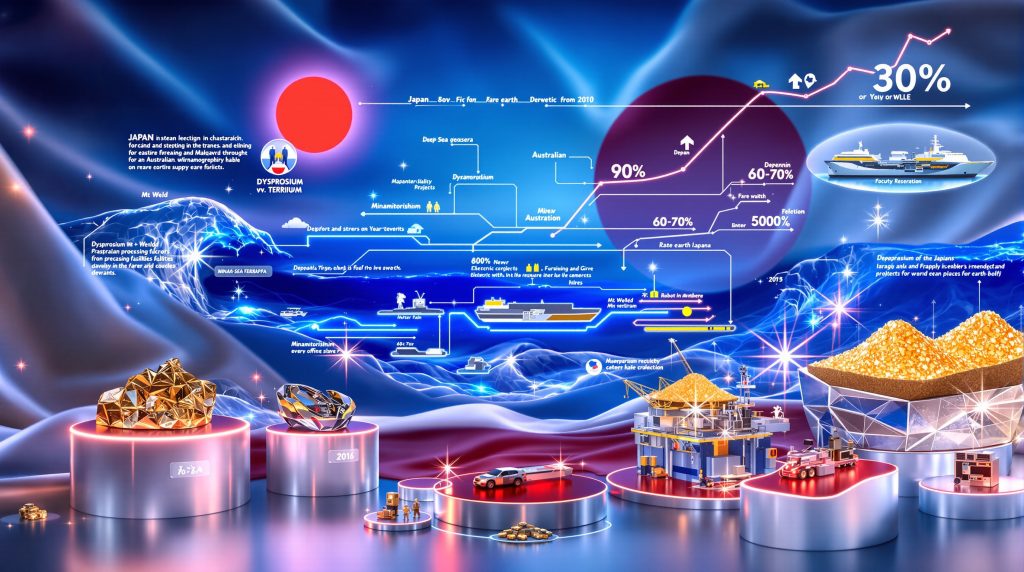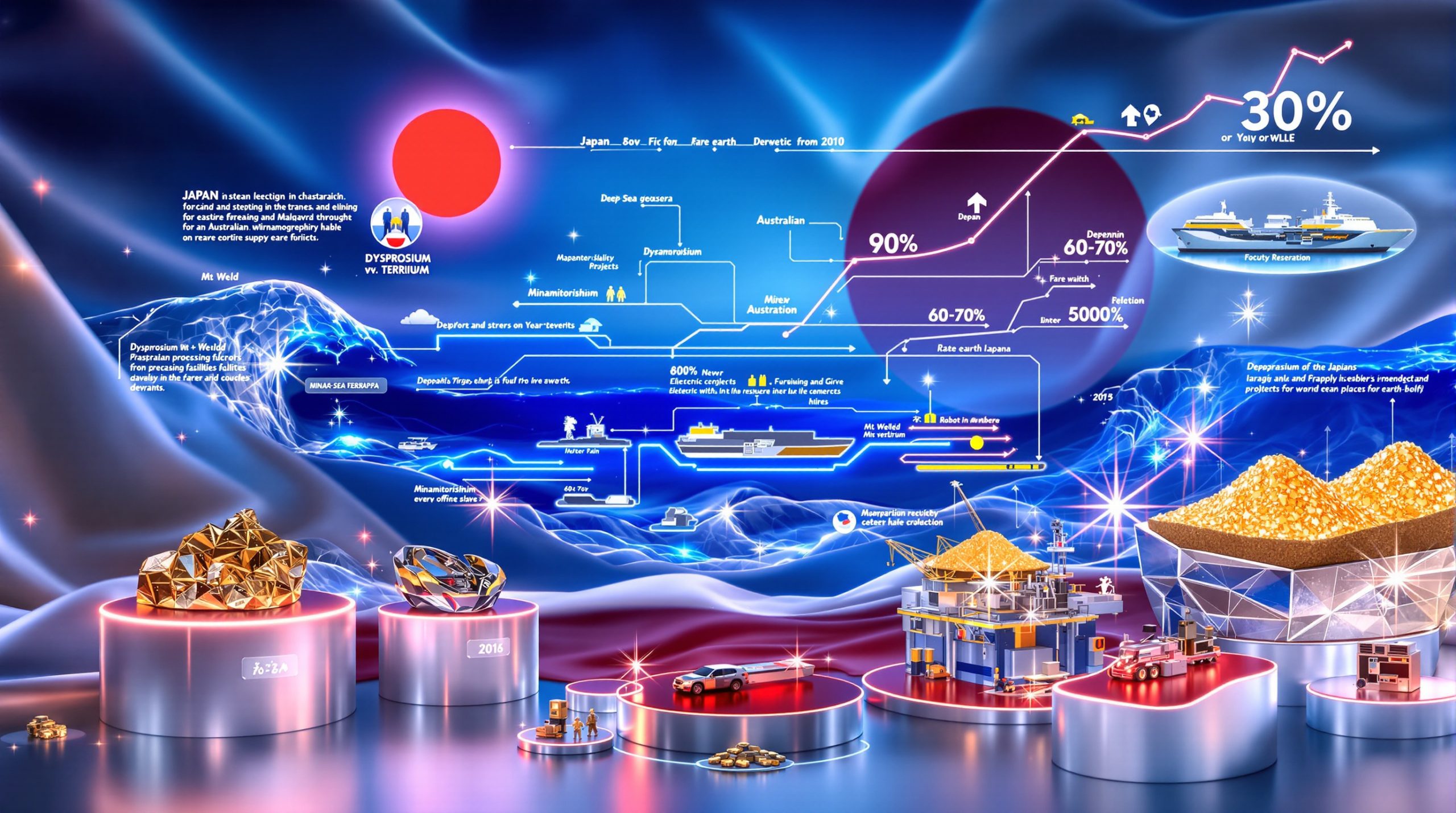Japan's Strategic Mineral Independence Revolution
Japan's transformation from complete dependence on Chinese rare earth elements to establishing diversified supply networks represents one of the most significant shifts in global critical minerals security over the past decade. This strategic pivot has fundamentally altered the Japan heavy rare earth supply chain, with implications that extend far beyond Japan's borders. The nation's systematic approach to reducing supply chain vulnerabilities demonstrates how targeted industrial policy can reshape entire sectors of the global economy.
The catalyst for this transformation emerged from China's near-monopoly control over global rare earth production and processing capabilities. With Chinese dominance spanning approximately 98-100% of heavy rare earth separation capacity, Japan faced an existential challenge to its manufacturing base. The automotive and robotics industries, which form the backbone of Japan's export economy, depend critically on materials that were previously available through a single geographic source.
This dependency created unprecedented vulnerability for a nation whose technological leadership relies heavily on advanced manufacturing capabilities. The recognition of this strategic weakness prompted a comprehensive reassessment of mineral security policy that would reshape international supply chains for years to come.
Understanding Heavy Rare Earths and Their Economic Significance
Heavy rare earth elements, particularly dysprosium and terbium, function as essential components in high-performance permanent magnet applications that power modern industrial systems. These elements serve as the thermal backbone of advanced NdFeB magnets, enabling magnetic properties to persist under elevated temperature conditions that would cause conventional magnets to fail.
Dysprosium applications span across multiple critical sectors:
• Electric vehicle traction motors requiring heat-resistant magnetic performance
• Industrial automation systems operating in high-temperature environments
• Aerospace propulsion and control systems
• Defense applications where reliability under thermal stress is paramount
Terbium serves complementary functions in similar applications, working synergistically with dysprosium to enhance magnetic coercivity and thermal stability. Without these elements, permanent magnets experience demagnetisation when exposed to operational temperatures exceeding 150-200°C, making them unsuitable for demanding industrial applications.
The distinction between light rare earth elements and heavy rare earth elements extends beyond simple periodic table classification. Light rare earths, including cerium, lanthanum, and neodymium, are relatively abundant and easier to extract. Heavy rare earths occur in much lower concentrations and require sophisticated separation processes, making them significantly more challenging to produce at commercial scale.
Furthermore, Japan's industrial dependence on heavy rare earths reflects the nation's position as a global leader in precision manufacturing. The automotive sector alone represents massive consumption volumes, with each electric vehicle motor containing several hundred grams of rare earth elements. As electrification accelerates globally, this demand continues to expand exponentially.
The robotics and automation industries similarly require consistent access to high-performance magnets for servo motors, actuators, and precision positioning systems. Japan's leadership in industrial robotics makes this sector particularly vulnerable to supply disruptions, as alternative materials cannot match the performance characteristics required for advanced manufacturing applications.
Strategic Dependency Reduction Through Diversification
The 2010 Chinese export restrictions served as a pivotal moment that exposed the fragility of single-source dependency for critical materials. When China implemented export controls on rare earth elements amid geopolitical tensions, Japan experienced immediate supply chain disruptions that threatened entire industrial sectors. This crisis catalysed a fundamental shift in national mineral security policy.
The Japan Organisation for Metals and Energy Security (JOGMEC) emerged as the primary governmental mechanism for implementing diversification strategies. Through targeted partnerships with mining companies and processing facilities outside China, JOGMEC established the institutional framework for reducing strategic vulnerability. This approach emphasised long-term relationship building rather than spot market transactions.
Japan's systematic approach to supply chain resilience involved multiple complementary strategies:
• Development of strategic stockpiles to buffer against short-term disruptions
• Investment in alternative processing capabilities outside Chinese control
• Research into substitution technologies to reduce absolute consumption requirements
• Establishment of recycling infrastructure to recover materials from end-of-life products
Consequently, the partnership framework developed during this period prioritised reliability and strategic alignment over purely economic considerations. Japan recognised that the lowest-cost supplier was not necessarily the most secure supplier, particularly for materials with such concentrated production geography.
Risk mitigation through multiple supplier relationships became a core principle guiding procurement decisions. Rather than simply replacing Chinese sources with alternative single sources, the strategy emphasised developing parallel supply chains that could provide redundancy and competitive pricing pressure.
The Strategic Significance of Sojitz-Lynas Collaboration
The partnership between Sojitz Corporation and Lynas Rare Earths represents the culmination of decades of strategic relationship building that traces back to the 1960s through predecessor company Nissho Iwai. This historical foundation provided the institutional knowledge and trust necessary to develop complex international supply arrangements.
In October 2025, Sojitz began importing dysprosium and terbium from Lynas facilities, marking the activation of the world's only operational heavy rare earth supply chain outside Chinese control. This development, highlighting the evolution of mining industry innovation, represents far more than a commercial transaction; it constitutes a fundamental shift in global mineral security architecture.
Japan Heavy Rare Earth Supply Chain Diversification Milestones
| Year | Development | Strategic Impact |
|---|---|---|
| 2010 | Chinese export restrictions | Exposed 90%+ dependency vulnerability |
| 2011 | Sojitz-Lynas exclusive agreement | Alternative sourcing foundation |
| 2023 | Dedicated Dy/Tb rights secured | Guaranteed Japanese access |
| 2025 | Commercial imports commence | Operational supply independence |
The JARE joint venture structure between Sojitz and JOGMEC demonstrates the integration of private sector commercial capabilities with government strategic objectives. This special-purpose vehicle has provided equity and loan financing to Lynas for over a decade, ensuring Japanese interests remain aligned with production capacity development.
The 2023 agreement that secured Japanese exclusive rights to dysprosium and terbium production triggered Lynas's acceleration of heavy rare earth production capacity. This arrangement ensures that Japan maintains priority access to materials essential for its industrial base, while providing Lynas with the long-term demand certainty necessary to justify capacity expansion investments.
The operational breakthrough achieved through this partnership cannot be overstated. With Chinese control of approximately 98-100% of global heavy rare earth separation capacity, the Lynas facility represents the singular alternative for industrial-scale production. The Mt. Weld deposits in Australia provide the ore feedstock, while Malaysian processing and refining operations convert raw materials into commercial-grade products.
However, this supply chain faces continuing challenges. Malaysia's evolving regulatory environment presents external risks that could impact heavy rare earth throughput. Industrial-scale production remains in early ramp-up phases, with specific volume data remaining proprietary. These factors introduce uncertainty despite the strategic breakthrough.
Deep-Sea Mining: Japan's Pursuit of Complete Independence
Japan's domestic deep-sea mining initiative represents an ambitious attempt to achieve complete supply independence through indigenous resource development. The Minamitorishima project targets rare earth mud deposits located approximately 1,950 kilometres offshore within Japan's Exclusive Economic Zone, offering the potential for centuries of supply security.
The technical advantages of marine rare earth deposits extend beyond simple resource availability. Ocean floor deposits typically contain lower levels of radioactive contamination compared to terrestrial sources, potentially simplifying processing requirements and reducing environmental management complexities. The isolated marine environment also minimises community impact concerns that often complicate land-based mining operations, although deep‐sea mining concerns remain significant.
Deep-sea extraction technologies under development for this project represent cutting-edge approaches to marine mineral recovery. The technical challenges include:
• Remotely operated vehicle systems for ocean floor material collection
• Hydraulic lifting mechanisms to transport materials to surface vessels
• Onboard processing capabilities for initial material concentration
• Environmental monitoring systems to minimise ecological disruption
The 2028 target timeline for extraction and processing operations reflects the aggressive development schedule driven by strategic necessity. Achieving this timeline requires simultaneous advancement in multiple technological domains, from subsea robotics to mineral processing chemistry.
Strategic implications of successful deep-sea mining development include:
• Complete elimination of foreign dependency for critical materials
• Potential transformation of Japan from importer to exporter of heavy rare earths
• Demonstration of technological capabilities that could influence global marine mining regulations
• Enhanced bargaining position in international trade negotiations
The environmental advantages of deep-sea mining compared to terrestrial operations remain subject to ongoing research and debate. While marine operations may avoid certain land-use conflicts and radioactive contamination issues, the long-term ecological impacts of deep-sea sediment disruption require careful evaluation.
Navigating Challenges in Supply Chain Transformation
Japan's Japan heavy rare earth supply chain strategy faces significant technical and operational hurdles that could impact long-term success. Deep-sea mining technology scalability represents perhaps the greatest uncertainty, as translating experimental capabilities into commercial-scale operations requires substantial technological advancement.
Processing capacity development presents another critical challenge. Even with successful ore extraction, Japan must develop sophisticated separation and refining capabilities that can match the quality and consistency of established Chinese operations. This requires not only capital investment but also acquisition of highly specialised technical expertise.
Quality control and consistency challenges become particularly acute when developing alternative supply sources. Industrial customers require materials that meet precise specifications with minimal variation, as even small deviations can impact final product performance. Establishing this consistency across new supply chains demands extensive process optimisation and quality assurance systems.
Geopolitical competition intensification poses additional challenges:
• United States and European nations actively seeking alternative rare earth sources
• Limited global processing capacity outside Chinese facilities creates bottlenecks
• Increasing competition for Lynas production capacity as other nations pursue supply security
• Potential for retaliatory measures from China as alternative supply chains develop
In addition, economic viability considerations add another layer of complexity to Japan's strategy. High development costs for domestic deep-sea mining projects require substantial upfront investment with uncertain returns. Price competitiveness with established Chinese suppliers remains challenging, particularly as China may use pricing as a strategic tool to undermine alternative supply development.
Long-term investment return uncertainties reflect the intersection of technological, geopolitical, and market risks. Investors must evaluate projects based on scenarios that include potential Chinese market manipulation, evolving regulatory environments, and uncertain technological development timelines.
Innovation and Market Impact of Japan's Approach
Japan's supply chain innovations extend beyond simple source diversification to encompass comprehensive circular economy integration. Advanced recycling programmes target end-of-life products containing rare earth elements, potentially recovering substantial quantities of materials that would otherwise require new mining, contributing to the broader sustainable mining transformation.
Separation and purification technologies developed for recycling applications often exceed the sophistication of primary processing operations. Recovering rare earths from complex manufactured products requires precise chemical processes that can separate target elements from diverse material matrices.
Closed-loop supply chain development represents a fundamental shift from linear consumption models to circular resource utilisation. This approach reduces absolute demand for newly mined materials while creating domestic sources of secondary supply that cannot be subject to foreign export restrictions.
Strategic stockpiling programmes provide additional buffer capacity against potential supply disruptions. Government-backed reserve accumulation ensures that critical industries can continue operations during temporary supply interruptions, while private sector inventory management optimises working capital requirements.
Technology substitution research focuses on multiple approaches:
• Reduced rare earth content in magnet formulations without performance degradation
• Alternative magnetic materials that can partially substitute for rare earth applications
• Enhanced efficiency improvements in motor designs to maximise performance from limited materials
• Hybrid approaches combining multiple magnetic technologies
Emergency response capability enhancement through diversified supply sources and strategic reserves provides industrial resilience that extends beyond normal market operations. This capability becomes particularly valuable during geopolitical crises or natural disasters that could disrupt primary supply chains.
Implications for Western Supply Chain Security
Japan's success in securing alternative heavy rare earth supply sources creates new competitive dynamics for United States and European markets seeking similar supply independence. With Japanese exclusive access to much of Lynas production capacity, Western nations face intensified competition for the limited non-Chinese supply available globally.
The pressure on MP Materials and other Western rare earth developers has intensified significantly as Japan demonstrates that alternative supply chains are both technically feasible and commercially viable. Timeline challenges for alternative supply development become more acute as available capacity becomes committed to existing partnerships.
Competitive implications for Western markets include:
• Limited access to proven non-Chinese production capacity
• Higher costs for securing alternative supply sources
• Extended development timelines for domestic production capabilities
• Increased strategic importance of recycling and substitution technologies
Regional supply chain resilience building may benefit from Japan's experience and technological development. Potential collaboration opportunities could include technology transfer arrangements, joint development projects, and coordinated responses to Chinese market dominance.
Furthermore, Japan's potential evolution into a regional hub for processed rare earth materials could provide neighbouring countries with access to secure supply sources. This transformation would require substantial additional investment in processing capacity and logistics infrastructure.
Lessons for allied nations' mineral security emerge from Japan's systematic approach to supply diversification. The importance of long-term partnership investment strategies, government-private sector collaboration models, and patient capital deployment becomes evident through Japan's experience.
Coordinated response capabilities among allied nations could enhance collective supply security while reducing individual country vulnerabilities. Sharing strategic reserves, coordinating development timelines, and establishing mutual supply agreements could strengthen overall resilience.
Future Prospects for Japan's Heavy Rare Earth Independence
The trajectory of Japan's Japan heavy rare earth supply chain evolution through 2025-2030 depends heavily on the successful execution of the Minamitorishima deep-sea mining project. Commercial viability of deep-sea extraction technologies could transform Japan from net importer to potential exporter of critical materials.
Lynas partnership expansion possibilities remain constrained by Malaysian processing capacity and regulatory approval processes. While the existing arrangement provides substantial supply security, scaling production to meet growing demand requires continued investment in processing infrastructure.
Technology advancement integration across multiple domains includes:
• Enhanced deep-sea extraction equipment and methodologies
• Improved separation and purification processes for marine-sourced materials
• Advanced recycling technologies for urban mining applications
• Substitution materials and efficiency improvements reducing absolute demand
However, global market impact scenarios suggest that successful Japanese domestic production could influence worldwide pricing structures and supply availability. The potential for Japanese rare earth exports would create a third major supply source alongside China and emerging Western production, similar to broader mining consolidation trends seen globally.
Competition with Chinese market dominance requires sustained technological advancement and cost competitiveness. China may respond to alternative supply development with pricing strategies designed to undermine economic viability of competing sources, particularly as critical minerals energy security becomes increasingly important.
Strategic recommendations for stakeholders:
• Investors: Evaluate opportunities in Japanese supply chain infrastructure, processing technologies, and recycling capabilities
• Industrial Users: Develop dual-sourcing strategies incorporating Japanese supply sources while building strategic inventory buffers
• Government Entities: Consider partnership opportunities with Japanese entities for technology transfer and joint development projects
• Mining Companies: Assess potential for joint ventures with Japanese partners to access capital and technical expertise
Risk management considerations must account for technological uncertainties in deep-sea mining, potential regulatory changes in Malaysia affecting Lynas operations, and evolving Chinese competitive responses to alternative supply development.
What Are the Key Success Factors for Japan's Strategy?
Japan's success stems from several critical factors that other nations can learn from. Long-term strategic planning has been fundamental, with partnerships like Sojitz-Lynas dating back decades rather than being reactive measures.
The integration of government policy with private sector capabilities through JOGMEC demonstrates effective public-private collaboration. Patient capital deployment has enabled sustained investment in alternative supply sources even when immediate returns were uncertain.
How Will This Impact Global Markets?
The emergence of Japanese supply independence fundamentally alters global rare earth market dynamics. With Japan securing exclusive access to significant Lynas production, other nations face increased competition for limited non-Chinese sources.
Price stability may improve as supply sources diversify, though initial costs remain elevated compared to Chinese alternatives. The demonstration effect of Japan's success encourages other nations to pursue similar strategies, potentially accelerating global supply diversification.
Disclaimer: This analysis contains forward-looking projections and assessments based on current information and trends. Actual developments may vary significantly due to technological, regulatory, geopolitical, and market factors beyond current prediction capabilities. Investment and strategic decisions should incorporate comprehensive due diligence and risk assessment appropriate to specific circumstances.
Japan's transformation from complete Chinese dependence to diversified heavy rare earth supply represents a fundamental shift in global critical minerals security architecture. Through strategic partnerships, technological innovation, and patient capital deployment, Japan has demonstrated that alternative supply chains are both feasible and commercially viable. This success creates new competitive dynamics for Western nations while establishing a model for mineral security that other countries may seek to replicate. The implications extend far beyond Japan's borders, influencing global supply chains, pricing structures, and the strategic balance of critical materials access that underpins modern technological civilisation. According to the US-Japan critical minerals framework, this collaboration represents a significant step toward enhancing supply chain security for both nations. Furthermore, as highlighted by Japan's Nikkei analysis, this strategic shift demonstrates Japan's commitment to reducing dependence on Chinese rare earth supplies while building more resilient supply chains for the future.
Ready to Position Yourself for the Next Critical Minerals Discovery?
Discovery Alert's proprietary Discovery IQ model instantly identifies significant mineral discoveries across the ASX, including critical metals essential for technological advancement. Understanding why major mineral discoveries can lead to substantial market returns by exploring Discovery Alert's dedicated discoveries page, showcasing historic examples of exceptional outcomes, whilst beginning your 30-day free trial today to secure your market-leading advantage.




